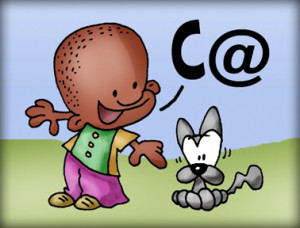Symbols
- September 25, 2014
- By Michael Kline

Spoiler alert! Your spell-checking grammar-massaging typo-managing browser may not see eye to eye with this activity, but sometimes you just have to trust the content.
When I wrote WordPlay Café back in 2004, I was intrigued by the power of words and symbols and their ability to be twisted, toppled, and rearranged in countless ways. But I was also quite smitten with those “other” objects; as in the symbols, the punctuation, the accents… All of those typographic devices that serve a very distinct purpose, being to flavor our writing and reading experience, and provide us with a few rules along the way.
Those devices also have names. Consider a few of those: Exclamation points, periods, commas, colons, semi-colons, dashes, hyphens, (parentheses… LOL), brackets and braces, apostrophes, quotation marks, and ellipses, just to name a few.
Then there are the accents: Acutes, circumflexes, graves, tildes, and umlauts. If you consider math symbols as well (pluses, minuses, times, divisions, is-greater-thans, etc.), there exists a wealth of keyboard options that easily match the ability of 26 characters and 10 numbers to convey a thought.
All of these things have a job to do, but being a person who loves to challenge things, I’ve found another purpose for them. Rather than just use them, I listen to them.
Consider the following sentence: “Seeing a r@ run through the s&box made no ¢s to Kevin, + it made his heart # to see such an animal –ing around the yard.” It may first appear that you’ve stumbled across a bizarre text message from one of your students, but the difference here is that I’ve not really shortened or abbreviated anything. I’ve merely used the sounds, or phonetic equivalents of the symbols to stand in for words or parts of words. Here is the sentence with those symbols spelled out: “Seeing a rat run through the sandbox made no sense to Kevin, plus it made his heart pound to see such an animal dashing through the yard.”
So grab your students, and let’s prepare a low-f@ symbol s&wich.
There are a couple of ways to approach this unique writing exercise with something I call the hunter/gatherer method. You can have your students hunt down sentences or phrases from the newspaper, a book, a famous quotation or poem, then have them find any instances where a symbol may be traded for a word or part of a word and either circle it or make note of it. Conversely, you can ask your students to contrive their own sentences by gathering well known symbols and constructing a simple paragraph using those symbols.
Have your students share their hunted or gathered choices with each other and compare notes. You can also have them display their profound observations on the walls outside of your classroom–something which is certain to spark rumors among other students and teachers.
If you find the activity a bit taxing, consider allowing the ten numbers to enter the fray as there are some gr8 phonetic equivalents in those. And if it’s not obvious, when someone (like myself) makes up a word game, playing fast and loose with the rules is par for the course. And that’s what you should do too! Experimentation is the best way to find the most fun in any exercise, especially when it comes to dismantling the English language.
Right now, I have 2 –. I’ve been wanting to watch The C@ in the H@.
Teach. Learn. Enjoy!

Kids Discover Talks with Television Lighting Designer Christopher Landy About the Rockefeller Center Christmas Tree Lighting
- December 9, 2025

It’s the Most Wonderful Time of the Year… For Community Service Projects!
- December 8, 2025

The Rockefeller Center Christmas Tree Lights the 2025 Holiday Season in New York City
- December 3, 2025